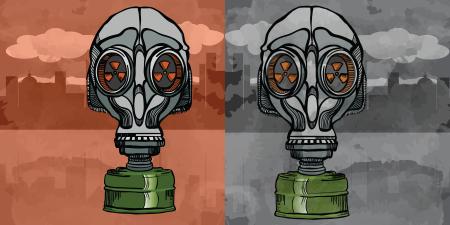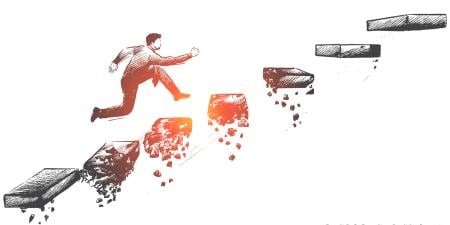As the United States has focused on its vulnerability to violent terrorist acts, it has turned to protectionist initiatives in political and economic policies and defensive measures such as biodefense and emergency preparedness programs in health policy. Arguing that their efforts will afford needed protection from bioterrorist threats and also strengthen the health system, the nation's leaders have called upon health professionals to play a central role in securing the homeland.1,2,3,4 On this new landscape, emergency planning and response revolve more than ever around complex emergencies, where human action plays a role in creating crisis.5,6
Much has been said about first responders, physicians, and other health professionals' obligations to participate in emergency preparedness efforts, to face great danger, and to confront new and difficult moral questions in an actual crisis. Considerably more discussion is needed on the social and institutional policies that should exist to support health care professionals in these endeavors. Here I hope to shift the conversation toward what is owed to health professionals both as they prepare to face possible crisis and also in their longer-term project of protecting and promoting the nation's health. Social norms, economic structures, and institutional processes demand our attention because they can support (or undermine) health professionals' ability to defend public health, protect their own bodily integrity, and uphold key ethical ideals.
Giving Health Professionals Their Due in the Face of Disaster
Emergency preparedness now captures the energies and expertise not only of first responders and emergency physicians and nurses but virtually all clinicians and public health professionals—and increasingly defines the specific ends which organize their work. Many health professionals find themselves working to secure funding from the "war chest" set aside by the federal government for research on biological pathogens and medical countermeasures.7,8,9 Others are redesigning public health statutes and forging new links with law enforcement.10,11 Education in emergency preparedness—with emphasis on bioterrorism and weapons of mass destruction—currently constitutes part of the preferred curriculum for medical students and other health professionals in training.12,13,14,15,16,17,18 Public health agencies, academic health centers, and physician specialists have organized task forces and defined competencies for readiness and protocols for emergency response.19,20,21,22,23,24,25,26,27,28,29,30,31 Some health professionals have found themselves serving as participants in (highly controversial) studies of the smallpox vaccine.32
It appears, however, that "readiness" remains an elusive goal.33,34,35,36 Evidence suggests that needed resources—including protective equipment, personnel, facilities, and information regarding past experiences with bioterrorism—are lacking.37,38,39,40,41,42,43,44,45,46 This presents serious ethical concerns for public health and health professionals, especially those who would serve as first responders, given pervasive expectations that they come forward to serve in a crisis.
Indeed, along with calls from the nation's leaders, legal obligations and ethical codes compel health professionals to confront danger. Under the force of law, and specifically the Emergency Medical Treatment and Active Labor Act (EMTALA), emergency departments are required to stabilize patients in need of emergency care. Proposed revisions to public health statutes require some health professionals to give care in an emergency as a condition of licensure.47 More generally, federal authorities and health care accreditation organizations mandate participation in the National Disaster Medical System.48
Ethics codes generally give less explicit directives but can make strong moral claims on health professionals. The American Medical Association, for example, stops short of postulating a duty but nevertheless calls for physicians to "apply [their] knowledge and skills when needed though doing so may put [them] at risk."49 According to the American Nurses Association, nurses are obligated to provide care in certain circumstances (emergency not noted), yet they also have duties to themselves, namely to preserve their integrity and safety.50 At the same time, the National Association of Emergency Medical Services Physicians notes that "prehospital care providers have no duty to place themselves at risk for the benefit of another."51 Although not an ethics code, the Association of American Medical College's report on training future physicians for crisis at once refers to "professional obligations to treat" and "rights to protect . . . personal safety." 12 While many codes thus reveal tensions between obligations to others and to self, health professionals are left to determine which holds the most moral weight.
It appears, at least at present, that requirements and entreaties for health professionals to face the grave dangers presented by bioterrorism or weapons of mass destruction fail to meet the ethical principle of proportionality, which holds that policies and practices are ethically justifiable when the risks of harm are minimized and reasonable in relation to anticipated benefits. To be sure, the expertise of health professionals would bring great benefit to public health in a disaster. Yet, without adequate resources, health professionals' capacities to protect their own bodily integrity in a crisis is severely impaired. This in turn poses serious risks for the health of the public.
If the risks of harm are to be minimized and the principle of proportionality is to be met, it is essential to transform features of social and institutional context that undermine the provision of adequate resources and other needed support for health professionals. Economic structures, such as existing processes for reimbursement to health care institutions, are one example. Factors contributing to state budget deficits also demand attention. Taking a broader view, sustained financial support for strengthening the health system and its personnel has not been a priority for policy makers, a problem that has contributed to an overburdened health system and an inadequate pool of available health professionals as well as difficulties in recruiting.52 Social norms also undervalue caregiving work, making it difficult to recruit new health workers. Sustained financial support for the health system and strategies for shifting social norms toward heightened respect for the work of caregivers should be moral priorities for policy makers in any case, but most certainly given expectations that health professionals will face danger for the sake of others in an emergency.
In perhaps the most visible initiative aimed at minimizing the risks of harm for a subset of health professionals, federal officials launched the smallpox vaccination program in 2003. While appreciative of this effort to provide them, and in turn, the public, with added protection, not all health professionals accepted the proposition that taking the vaccine was their duty. The refusal of some to participate in the vaccination program revealed the tension between health professionals' duties to others and their right to protect their own bodily integrity. Indeed, supporters of the smallpox vaccination program showed contempt for those who raised questions about the program or rejected it altogether. There are, they argued, "moral and medical reasons to deplore the decisions of physicians and hospital officials who opt[ed] not to participate. . . . Their job is not to assess intelligence risks or second guess public health officials."53 Reflection and debate over the program were construed not as exercises of autonomy, but instead as expressions of ingratitude, and seen as dangerous impediments to protecting against an imminent attack.
In a security-conscious environment, it might be assumed that by accepting the protection the government affords, we tacitly consent to any measures it deems necessary to protect us—including those that entail sacrifices of liberty. Yet, to the extent that such an assumption holds, unquestioning deference to authority can become the norm, which undermines the autonomy of health professionals as individual moral agents. An operating assumption of tacit consent also thwarts medical professionals' abilities to contribute to policy and, in turn, could compromise public health and safety.
Past experience suggests that when health professionals lack decision-making authority in a health emergency with national security implications, the health of the public suffers. When collaborating with other agencies, divergent institutional norms, objectives, and processes can thwart health professionals' efforts. Allegations about how the FBI and military officials' secrecy may have hindered the CDC's assessment, and in turn, swift and effective response to the anthrax-laced letters are an especially poignant example [54]. Most recently, health professionals have found frustration with Department of Defense officials over a study on the anthrax incidents that was censored for 2 years—and that is still not available in its entirety—on the basis of national security.31,32,33,34,35,36,37,38,39,40,41,42,43,44,45,46,47,48,49,50,51 Unless we achieve consensus on ideal decision-making structures and processes between justice authorities and health officials during crisis preparation and response, we risk undermining health protection.
Besides developing ethically defensible decision-making structures among agencies and institutions, it is essential to train individual clinicians in ethical decision making in crisis situations so they can effectively treat patients and provide information to colleagues and to the public. This means challenging institutional and professional norms that can marginalize ethics in the curriculum. Providing them with this essential resource will help clinicians minimize the risk to the public and will support ethical ideals such as respect for autonomy, privacy, and equality, and fair resource allocation in the face of challenges that, without preparation, could be overwhelming.55
The Long-term Project: Protecting and Promoting Health
As we have seen, the assumption that social organization and cooperation should center around security has led to preparedness initiatives aimed at controlling or containing the health consequences of future acts of aggression. Yet the current emphasis on emergency preparedness presents profound social justice concerns. Society's vulnerable members and health professionals will be the most affected if emergency response planning diverts resources from urgently needed prevention and health promotion endeavors and from under-resourced hospitals, nursing and other health professional shortages, and the growing population who are underinsured or uninsured.52,56,57,58 The diversion of resources may undermine the nation's health and perpetuate, or even worsen, health disparities. This circumstance constrains health professionals capabilities to uphold the ideal of social justice. Economic and other structural reforms in health care and the public health system are urgently needed if social justice is to be recognizable in the health system and if emergency preparedness efforts are to have any hope of success.
Our methods for threat assessment and the role for health professionals in bioterrorism protections call for scrutiny. Some health policy makers believe the current focus on medical control or containment of extreme events rests upon highly controversial assumptions and reductive models for understanding the nature of the threat. The present approach may represent a troublesome retreat from advances in social medicine and social epidemiology. To understand the nature of the threat, we might also concentrate on the global economic structures that contribute to unstable production systems and jobs markets, weak democracies, the erosion of cultural identity and political freedoms, and the international weapons trade. Health professionals should work to enhance self-determination and equality and promote health security around the world instead of being compelled to focus their cooperative efforts on emergency preparedness on the homefront. Health professionals can play a vital role in addressing these and other social determinants of health;59 yet present policy constrains their capacities to effectively promote health and to support social justice globally.
Emergency preparedness initiatives constitute an integral part of health systems globally. The changing landscape of health policy and practice presents ethical complexities about how to secure health and support the efforts of health professionals in the face of disaster and over time. It is essential to direct our attention to social and professional norms, institutional arrangements, and economic structures in the current context, and assess how they enhance or undermine ethical principles and ideals.
References
- Nunn S. The future of public health preparedness. J Law Med Ethics. 2002;30(3 Suppl):202-209.
- Gerberding JL, Hughes JM, Koplan JP. Bioterrorism preparedness and response: clinicians and public health agencies as essential partners. JAMA. 2002;287(7):898-900.
-
Bush GW. President promotes funding for emergency first responders [transcript]. March 27, 2002. Accessed April 2, 2004.
-
Ridge T. Director Ridge speaks at American Hospital Association meeting. April 8, 2002. Accessed April 2, 2004.
- Poe BM. Expanding disaster preparedness to include bioterrorism. Am J Health Syst Pharm. 2002;59(10):926-927.
-
Bok S. The new ethical boundaries. In: Leaning J, Briggs SM, Chen LC, eds. Humanitarian Crises: The Medical and Public Health Response. Cambridge, MA: Harvard University Press; 1999:179-193. Here I will use the terms "emergency", "crisis" and "disaster" interchangeably, relying upon the following definition: sudden calamitous events that demand urgent attention.
- Enserink M. One year after: hunt for NIH funds fosters collaboration. Science. 2002;297(5587):1630-1631.
- Malakoff D. Protecting the homeland sets tone for 2004 budget. Science. 2003;299(5608):806-808.
-
Fauci AS. Biodefence on the research agenda. Nature. 2003;421:787.
-
Center for Law and the Public's Health. Accessed March 13, 2004.
- Noji EK. Creating a health care agenda for the Department of Homeland Security. Manag Care. 2003;12(11 suppl):7-12.
-
Association of American Medical Colleges. Training Future Physicians About Weapons of Mass Destruction: Report of the Expert Panel on Bioterrorism Education for Medical Students. Washington, DC: AAMC; 2003. Accessed April 1, 2004.
-
Waeckerle JF, Seamans S, Whiteside M et al for the Task Force of Health Care and Emergency Services Professionals on Preparedness for Nuclear, Biological, and Chemical Incidents. Executive summary: developing objectives, content, and competencies for the training of emergency medical technicians, emergency physicians, and emergency nurses to care for casualties resulting from nuclear, biological, or chemical incidents. Ann Emerg Med. 2001;37:587-601.
-
New academic centers for public health preparedness funded. Public Health Reports. 2002;117:592.
-
Agency for Healthcare Research and Quality. Training Clinicians for Public Health Events Relevant to Bioterrorism Preparedness.Accessed March 15, 2004.
- Filoromo C, Macrina D, Pryor E, Terndrup T, McNutt SD. An innovative approach to training hospital-based clinicians for bioterrorist attacks. Am J Infec Control. 2003;31(8):511-514.
- Veenema TG. Chemical and biological terrorism preparedness for staff development specialists. J Nurses Staff Dev. 2003;19(5):218-225.
- Torne CD, Curbow B, Oliver M, al-Ibrahim M, McDiarmid M. Terrorism preparedness training for nonclinical hospital workers: empowering them to take action. J Occup Environ Med. 2003;45(3):333-337.
-
American Hospital Association, Office of Emergency Preparedness, Department of Health and Human Services. Hospital Preparedness for Mass Casualties. Chicago: AHA; 2000.
-
Centers for Disease Control and Prevention (CDC). Biological and chemical terrorism: strategic plan for preparedness and response. Recommendations of the CDC Strategic Planning Workgroup. MMWR Morbid Mortal Wkly Rep. April 21, 2000;49:1-14.
-
Centers for Disease Control and Prevention. State Emergency Preparedness and Response Inventory. Atlanta, GA: CDC; February 2002. Accessed April 13, 2004.
-
Perry RW, Lindell MK. Preparedness for emergency response: guidelines for the emergency planning process. Disasters.2003;27:336-350.
-
Mills-Senn P. Preparedness: Biodefense network. Hosp Health Netw. 2003;77:20, 22.
-
Association of State and Territorial Health Officials (ASTHO). Bioterrorism Preparednesss. Accessed April 2, 2004.
-
Fraser MR, Fisher VS. Elements of Effective Bioterrorism Preparedness: A Planning Primer for Local Public Health Agencies.National Association of County and City Health Officials (NACCHO). Accessed April 2, 2004.
-
National Association of County and City Health Officials. NACCHO Responds to Bioterrorism. Accessed April 2, 2004.
-
American Medical Association. Disaster Preparedness. Accessed April 2, 2004.
-
Rubin ER, Osterweis M, Lindeman LM, eds. Emergency Preparedness and Beyond. Washington, DC: Association of Academic Health Centers; 2002.
-
American College of Emergency Physicians. Positioning America's Emergency Health System to Respond to Acts of Terrorism. Accessed April 2, 2004.
-
American Academy of Pediatrics. AAP task force on terrorism to help prepare pediatricians for disaster response. AAP News. 2002;20:4.
-
American College of Surgeons. Disasters from Biological and Chemical Terrorism—What Should the Individual Surgeon Do? A Report from the Committee on Trauma. Accessed March 23, 2004.
- Stephenson J. Smallpox vaccine program launched amid concerns raised by expert panel, unions. JAMA. 2003;289(6):685-690.
-
Heyman D. Lessons from the Anthrax Attacks: Implications for US Bioterrorism Preparedness. April 2002. Unpublished report. Available at: www.fas.org. Accessed March 29, 2004.
-
Knobler SL, Mahmoud AAF, Pray LA, eds. Biological Threats and Terrorism: Assessing the Science and Response Capabilities.Washington, DC: National Academies Press; 2002.
-
Trust for America's Health. Ready or Not? Protecting the Public's Health in the Age of Bioterrorism. 2003. Accessed March 29, 2004.
-
United States General Accounting Office (USGAO). Combating Terrorism: Evaluation of Selected Characteristics in National Strategies Related to Terrorism. Pub no GAO-04-408T. Washington, DC: United States General Accounting Office; February 2004. Accessed April 14, 2004.
-
Clarke RA, Metzl JF, Rudman WB. Emergency Responders: Drastically Underfunded, Dangerously Underprepared. Washington, DC: Council on Foreign Relations; 2003.
-
Jackson BA, Peterson DJ, Bartis JT, et al. Protecting Emergency Responders. Santa Monica, Calif: RAND; 2003. Accessed April 14, 2004.
-
Centers for Disease Control (CDC). Terrorism preparedness in state health departments—United States, 2001-2003. MMWR Morbid Mortal Wkly Rep. Oct 31, 2003;52:1051-1053;
-
CDC. Assessment of the epidemiologic capacity in state and territorial health departments--United States, 2001. MMWR Morbid Mortal Wkly Rep. Oct 31, 2003;52:1049-1051.
-
Chemical-terrorism preparedness--public health laboratories found unprepared and overwhelmed. J Environ Health. 2003;66:35-36.
-
Fong T. Preparing for disaster: healthcare providers try to ready themselves for biological, chemical attacks without the benefit of government funding. Mod Healthc. 2003;33:2-7,16.
-
United States General Accounting Office Severe Acute Respiratory Syndrome: Established Infectious Disease Control Measures Helped Contain Spread But A Large Scale Resurgence May Pose Challenges. Pub no GAO-03-1058T. Washington, DC: USGAO; July 2003.
-
USGAO. Hospital Preparedness: Most Urban Hospitals Have Emergency Plnas But Lack Certain capacities for Bioterrorism Response. Pub no GAO 03-924. Washington, DC: USGAO; August 2003.
-
USGAO. Public Health Preparedness: Response Capacity Improving but Much Remains to be Accomplished. Pub no GAO 04-458T. Washington, DC: USGAO; February 2004.
-
Miller J. Censored study on bioterror doubts US preparedness. New York Times. March 29, 2004.
-
Gostin LO. The model state emergency health powers act. Center for Law and the Public's Health. Accessed March 13, 2004.
-
Department of Health and Human Services. What is the hospital's role in NDMS? Available at: http://ndms.dhhs.gov. Accessed March 13, 2004.
-
American Medical Association. Declaration of professional responsibility: medicine's social contract with humanity. September 2001. Accessed April 13, 2004.
-
American Nurses Association. Code of Ethics. 2001. Accessed April 2, 2004.
-
National Association of Emergency Medical Services Physicians. Ethics Committee. Ethical Challenges in Emergency Medical Services. Accessed March 29, 2004.
-
Institute of Medicine. The Future of the Public's Health in the 21st Century. Washington, DC: National Academies Press; 2003.
-
Connolly C. Two hospitals refuse call to vaccinate workers. Washington Post. December 18, 2002.
-
Siegel M. The anthrax fumble. The Nation. March 18, 2002;14,16,18.
-
For an overview of salient ethical issues, see Moreno JD, ed. In the Wake of Terror: Medicine and Morality in a Time of Crisis. Cambridge, Mass: MIT; 2003.
-
Mith S. Anthrax vs the flu: as state governments slash their public health budgets, federal money is pouring in for bioterrorism preparedness. Boston Globe. July 29, 2003.
-
Public health spending decreasing while anti-terrorism funds swell. AP State and Local Wire. January 6, 2004.
-
Staiti AB, Katz A, Hoadley JF. Has Bioterrorism Preparedness Improved Public Health? Center for Studying Health System Change. Issue brief no 65; July 2003. Accessed April 14, 2004.
- Sidel VW. Bioterrorism in the United States: a balanced assessment of risk and response. Med Confl Surviv. 2003;19(4):318-325.



